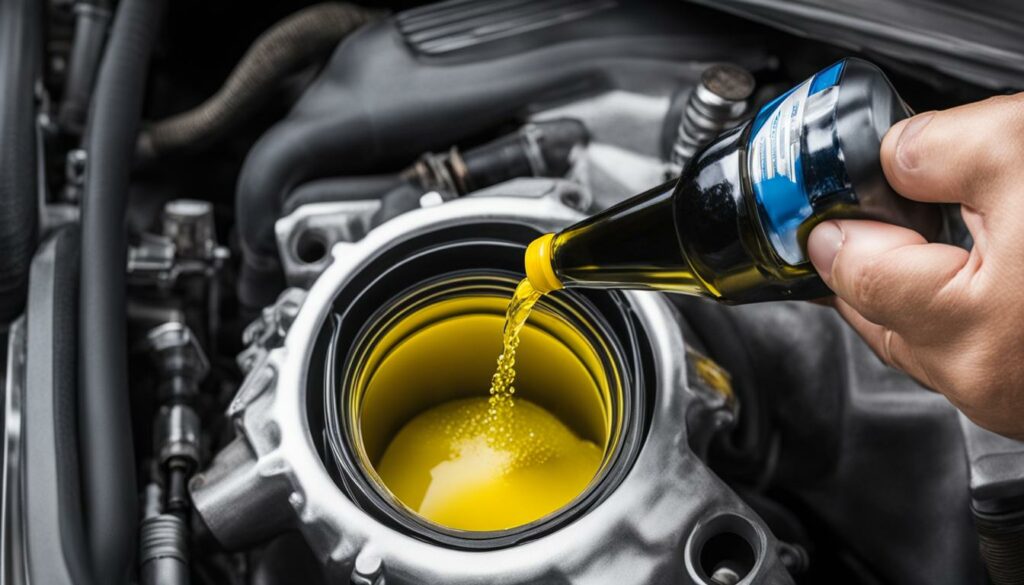If you own a car, you know how important it is to maintain it properly. One of the most critical components of your vehicle’s exhaust system is the catalytic converter. Not only does it help reduce harmful emissions, but it also plays a crucial role in improving fuel efficiency and performance. However, like any other part of your car, your catalytic converter can develop problems over time, and repairs can be expensive.
Fortunately, there are cost-saving tips and tricks you can use to fix your catalytic converter without breaking the bank. In this section, we’ll explore some of the cheapest ways to address catalytic converter issues and keep your car running smoothly.
Key Takeaways:
- Regular maintenance and cleaning can help keep your catalytic converter functioning well.
- Catalytic converter cleaner additives are a cost-effective way to improve performance.
- Aftermarket catalytic converters may be cheaper than OEM parts.
- DIY repairs can save on labor costs, but be cautious and ensure you know what you’re doing.
- Professional services may be necessary for more complex repairs, but you can still find affordable options.
Understanding Catalytic Converter Problems
If you’re experiencing issues with your car’s performance or emission standards, it’s essential to understand the common problems that can arise with your catalytic converter. Ignoring these problems can lead to more extensive and expensive damage to your vehicle.
One of the most common symptoms of catalytic converter problems is a check engine light on your dashboard. However, other indicators can signal an issue, such as reduced acceleration, decreased fuel efficiency, and a sulfuric smell emanating from your car’s exhaust.
There are several reasons why your catalytic converter may malfunction, including:
- Contamination from engine misfires and oil consumption
- Damage from road debris or collisions
- Age and wear and tear
To diagnose the issue, you may need to take your car to a mechanic for a professional inspection. They can use specialized equipment to check for error codes and measure the converter’s performance.
Understanding the signs and symptoms of catalytic converter problems can help you catch issues early on and avoid more expensive repairs down the line.
Example of Common Issues with Catalytic Converters:
| Issue | Symptoms |
|---|---|
| Converter clogging | Reduced acceleration, decreased fuel efficiency, black smoke from exhaust |
| Contamination | Sulfur smell from exhaust, poor engine performance, check engine light |
| Physical damage | Rattling noise from under the car, check engine light, poor engine performance |
Knowing these common issues and identifying any symptoms can help you save money and keep your car running smoothly.
Regular Maintenance and Cleaning
If you want to save money on your catalytic converter repair, regular maintenance and cleaning can be an effective and affordable option. By keeping your car’s emissions components clean and functioning correctly, you can avoid expensive repairs and replacements down the road.
Regular maintenance includes checking for any signs of wear and tear, such as cracks or leaks in the exhaust system, and replacing any damaged parts promptly. You can also opt to have your car inspected by a professional mechanic periodically to ensure that all components are working correctly.
In addition to regular maintenance, cleaning your catalytic converter can also help maintain its efficiency. Over time, carbon buildup can reduce the effectiveness of the catalyst, leading to increased emissions and decreased fuel economy. Using a specialized catalytic converter cleaner additive, which is available at most auto parts stores, can help remove this buildup and restore your converter’s performance.
| Benefits of Regular Maintenance and Cleaning | Considerations |
|---|---|
|
|
When cleaning your catalytic converter, it’s essential to follow the manufacturer’s instructions carefully to avoid any damage. Using the wrong type of product or overusing the cleaner can lead to severe consequences, including a damaged converter or engine. If you’re not comfortable cleaning the converter yourself, it’s best to seek professional assistance.
By regularly maintaining and cleaning your catalytic converter, you can avoid costly repairs and replacements while keeping your car running efficiently and environmentally friendly.

Tip: To get the most out of your cleaner additive, make sure to follow the product instructions carefully. You may need to use the product several times over a period of weeks to achieve the best results.
Seeking Professional Services
If you’re not comfortable fixing your catalytic converter issues on your own, seeking professional assistance is always an option. While it can be costly, there are ways to minimize expenses and find reliable repair services. Here are some tips:
- Research: Do your due diligence before choosing a repair shop. Look for reviews and ratings from previous customers, and check if they have the necessary certifications and licenses.
- Compare prices: Don’t settle for the first quote you receive. Contact multiple repair shops and compare their estimates to find the most affordable option.
- Be upfront and clear: When speaking with the mechanic, be transparent about your budget and ask for cost-saving options. They may be able to offer a cheaper solution or suggest parts that are more affordable without compromising quality.
- Check for warranties: Ask if the repair work comes with warranties or guarantees. This can save you money if any issues arise after the repair.
By following these tips, you can find a reliable and affordable professional to fix your catalytic converter problems. However, keep in mind that some repairs may still be costly, especially if the issue is severe. Be prepared to discuss payment options and prioritize the repairs that are most crucial for your car’s performance and safety.
Opt for Aftermarket Catalytic Converters
If you’re looking for a more affordable option to OEM parts, aftermarket catalytic converters could be a suitable alternative. These types of converters are designed to function similarly to OEM parts but are available at a lower price point.
One of the main benefits of choosing an aftermarket catalytic converter is the cost savings. They can be up to 50% cheaper than OEM parts, making them an attractive option for car owners on a budget.
Additionally, aftermarket options are widely available, making it easier to find the right part for your vehicle. Many reputable brands offer aftermarket catalytic converters, ensuring quality replacements for your car.
| Benefits | Considerations |
|---|---|
|
|
When opting for aftermarket catalytic converters, it’s essential to choose a reputable brand that offers quality replacements. You’ll also want to ensure that the part meets emission standards to comply with environmental regulations.
Overall, if you’re looking to save money on your catalytic converter repairs, considering aftermarket options could be a cost-effective solution. Just make sure to do your research and choose a reliable brand that meets your vehicle’s specifications and environmental requirements.
DIY Solutions for Catalytic Converter Problems
If you’re mechanically inclined and looking to save money on car repairs, fixing certain catalytic converter issues yourself can be a cost-effective solution. Here are some DIY tips to get you started:
- Identify the problem: Before attempting any DIY repairs, diagnose the problem with your catalytic converter. Common issues include clogging, contamination, and damage to the internal structure. Once you know the issue, research the necessary tools and techniques to address it.
- Clean the converter: Using a catalytic converter cleaner additive can help improve efficiency and remove contaminants. Follow the instructions on the product carefully and wear suitable protective gear.
- Replace oxygen sensors: Faulty oxygen sensors can cause issues with the catalytic converter’s performance. Replacing them can be a relatively easy DIY task, requiring a socket wrench and a new sensor.
- Repair exhaust leaks: Leaks in the exhaust system can cause damage to the catalytic converter. Inspect the system thoroughly and repair any leaks using high-heat resistant sealant or welding equipment.
- Replace the catalytic converter: While not ideal, replacing the catalytic converter yourself can save a significant amount of money on labor costs. Ensure you choose a suitable replacement and follow the manufacturer’s instructions carefully.
It’s essential to note that some catalytic converter problems may be beyond the scope of DIY repairs. If you’re unsure or uncomfortable performing repairs, seek professional assistance.
By following these DIY tips, you can potentially save hundreds of dollars on catalytic converter repairs. Remember to prioritize your safety and the proper functioning of your vehicle, and don’t hesitate to seek professional help if needed.
Conclusion
Now that you have explored the cheapest ways to fix catalytic converter issues, you can save money on car repairs and maintenance. By understanding the common problems that can occur with your converter, you can identify when repairs are needed and take preventative measures to avoid costly issues.
Maintaining your catalytic converter through regular cleaning and using additives can help keep it functioning properly and efficiently. If you do need professional assistance, be sure to research and find a reliable and affordable service provider.
Consider aftermarket options for your repairs, as they can be a cheaper alternative to original equipment manufacturer parts. And if you’re up for a challenge, try out DIY solutions to fix certain catalytic converter problems on your own and save on labor costs.
Overall, prioritizing your car’s performance and emission standards is essential for a cost-effective and eco-friendly solution. With these cost-saving tips and solutions, you can keep your car running smoothly without putting a strain on your wallet.


